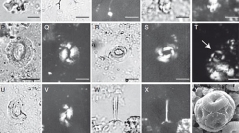

 Geodiversitas
30 (1) - Pages 59-77
Geodiversitas
30 (1) - Pages 59-77Fifty calcareous nannofossil species were listed in the upper Miocene deposits of the Northern Chelif Basin (Dahra, Ben Dourda section). The frequence of some of them (Discoaster loeblichii, D. quinqueramus, Amaurolithus primus and A. amplificus) suggests the presence of four subzones (NN10a, NN10b, NN11b, NN11c) which are assigned to the Tortonian and Messinian stages. The NN11a subzone is absent (hiatus), testified by the (first) simultaneous occurrence (FO) of D. quinqueramus and A. primus. In the same samples, planktonic foraminifera analysis revealed a comparable succession of biozones (Neogloboquadrina acostaensis, N. humerosa-N. dutertrei and Globorotalia mediterranea) which make possible a good calibration between biostratigraphic scales (calcareous nannofossils, foraminifera). The Tortonian-Messinian boundary is pointed out at the sample 28 of the section and characterized by the first occurrence (FO) of A. delicatus and Reticulofenestra rotaria on the one hand and G. mediterranea on the other hand. The assemblage analysis and relative abundance fluctuations of Coccolithus pelagicus and R. pseudoumbilicus show evidence of seven successive phases which are characterized, alternately, by cold and hot water marine masses, light intensity variations and nutrient availability.
Calcareous nannofossils, Foraminifera, Upper Miocene, biostratigraphy, paleoecology, Chelif Basin, Algeria